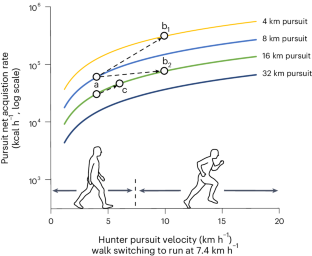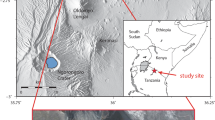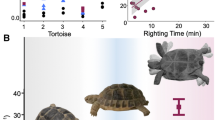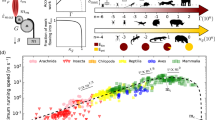Abstract
Humans have two features rare in mammals: our locomotor muscles are dominated by fatigue-resistant fibres and we effectively dissipate through sweating the metabolic heat generated through prolonged, elevated activity. A promising evolutionary explanation of these features is the endurance pursuit (EP) hypothesis, which argues that both traits evolved to facilitate running down game by persistence. However, this hypothesis has faced two challenges: running is energetically costly and accounts of EPs among late twentieth century foragers are rare. While both observations appear to suggest that EPs would be ineffective, we use foraging theory to demonstrate that EPs can be quite efficient. We likewise analyse an ethnohistoric and ethnographic database of nearly 400 EP cases representing 272 globally distributed locations. We provide estimates for return rates of EPs and argue that these are comparable to other pre-modern hunting methods in specified contexts. EP hunting as a method of food procurement would have probably been available and attractive to Plio/Pleistocene hominins.
This is a preview of subscription content, access via your institution
Access options
Access Nature and 54 other Nature Portfolio journals
Get Nature+, our best-value online-access subscription
$29.99 / 30 days
cancel any time
Subscribe to this journal
Receive 12 digital issues and online access to articles
$119.00 per year
only $9.92 per issue
Buy this article
- Purchase on Springer Link
- Instant access to full article PDF
Prices may be subject to local taxes which are calculated during checkout



Similar content being viewed by others
Data availability
All data presented in the paper are available in Supplementary Data 1, along with citations to their sources.
References
Bramble, D. M. & Lieberman, D. E. Endurance running and the evolution of Homo. Nature 432, 345–352 (2004).
Pontzer, H. Economy and endurance in human evolution. Curr. Biol. 27, R613–R621 (2017).
Lieberman, D. E. Exercised: Why Something We Never Evolved to Do Is Healthy and Rewarding (Pantheon Books, 2020).
Carrier, D. R. The energetic paradox of human running and hominid evolution. Curr. Anthropol. 25, 483–495 (1984).
Bogdanis, G. C., Nevill, M., Lakomy, H. & Boobis, L. Power output and muscle metabolism during and following recovery from 10 and 20s of maximal sprint exercise in humans. Acta Physiol. Scand. 163, 261–272 (1998).
Calbet, J. A. L. et al. Limitations to oxygen transport and utilization during sprint exercise in humans: evidence for a functional reserve in muscle O2 diffusing capacity. J. Physiol. 593, 4649–4664 (2015).
Sharp, N. C. C. Timed running speed of a cheetah (Acinonyx jubatus). J. Zool. 241, 493–494 (1997).
O’Neill, M. C., Umberger, B. R., Holowka, N. B., Larson, S. G. & Reiser, P. J. Chimpanzee super strength and human skeletal muscle evolution. Proc. Natl Acad. Sci. USA 114, 7343–7348 (2017).
Queeno, S. R. et al. Human and African ape myosin heavy chain content and the evolution of hominin skeletal muscle. Comp. Biochem. Physiol. A https://doi.org/10.1016/j.cbpa.2023.111415 (2023).
Baker, J. S., McCormick, M. C. & Robergs, R. A. Interaction among skeletal muscle metabolic energy systems during intense exercise. J. Nutr. Metab. 2010, 905612 (2010).
Mukund, K. & Subramaniam, S. Skeletal muscle: a review of molecular structure and function, in health and disease. Syst. Biol. Med. 12, e1462 (2020).
Best, A. W. Why does strength training improve endurance performance? Am. J. Hum. Biol. 33, e23526 (2020).
Schmidt-Nielsen, K. Desert Animals: Physiological Problems of Heat and Water (Clarendon Press, 1964).
Speakman, J. R. & Król, E. Maximal heat dissipation capacity and hyperthermia risk: neglected key factors in the ecology of endotherms. J. Anim. Ecol. 79, 726–746 (2010).
Kamberov, Y. G. et al. Comparative evidence for the independent evolution of hair and sweat gland traits in primates. J. Hum. Evol. 125, 99–105 (2018).
Saris, W. H. M. The role of sports foods in physical performance. in International Food Safety Handbook: Science, International Regulation, and Control (eds van der Heijden, K., Younes, M., Fishbein, L. & Miller, S.) Ch. 13 (CRC Press, 1999).
Newman, R. W. Why man is such a sweaty and thirsty naked animal: a speculative review. Hum. Biol. 42, 12–27 (1970).
Aldea, D. et al. Repeated mutation of a developmental enhancer contributed to human thermoregulatory evolution. Proc. Natl Acad. Sci. 118, e2021722118 (2021).
Kamberov, Y. G. et al. A genetic basis of variation in eccrine sweat gland and hair follicle density. Proc. Natl Acad. Sci. USA 112, 9932–9937 (2015).
Godfrey, R. W. et al. Evaluating the impact of breed, pregnancy, and hair coat on body temperature and sweating rate of hair sheep ewes in the tropics. J. Anim. Sci. 95, 2936–2942 (2017).
Asres, A. & Amha, N. Physiological adaptation of animals to the change of environment: a review. J. Biol. Agric. Healthc. 4, 146–151 (2014).
Hora, M., Pontzer, H., Struška, M., Entin, P. & Sládek, V. Comparing walking and running in persistence hunting. J. Hum. Evol. 172, 103247 (2022).
Montagu, A. Natural selection and man’s relative hairlessness. JAMA 187, 356–357 (1964).
Krantz, G. S. Brain size and hunting ability in earliest man. Curr. Anthropol. 9, 450–451 (1968).
Watanabe, H. Running, creeping and climbing: a new ecological and evolutionary perspective on human locomotion. Mankind 8, 1–13 (1971).
Bortz, W. M. Physical exercise as an evolutionary force. J. Hum. Evol. 14, 145–155 (1985).
MacArthur, R. H. & Pianka, E. R. On optimal use of a patchy environment. Am. Nat. 100, 603–609 (1966).
Bramble, D. M. & Carrier, D. R. Running and breathing in mammals. Science 219, 251–256 (1983).
Lieberman, D. E., Bramble, D. M., Raichlen, D. A. & Shea, J. J. in The First Humans - Origin and Early Evolution of the Genus Homo (eds Grine, F. E. et al.) 77–92 (Springer, 2009).
Liebenberg, L. Persistence hunting by modern hunter‐gatherers. Curr. Anthropol. 47, 1017–1026 (2006).
Liebenberg, L. The relevance of persistence hunting to human evolution. J. Hum. Evol. 55, 1156–1159 (2008).
Hora, M., Pontzer, H., Wall-Scheffler, C. M. & Sládek, V. Dehydration and persistence hunting in Homo erectus. J. Hum. Evol. 138, 102682 (2020).
Ruxton, G. D. & Wilkinson, D. M. Endurance running and its relevance to scavenging by early hominins. Evolution 67, 861–867 (2013).
Glaub, M. & Hall, C. A. S. Evolutionary implications of persistence hunting: an examination of energy return on investment for !Kung hunting. Hum. Ecol. 45, 393–401 (2017).
Vidal-Cordasco, M., Rodriguez, J., Prado-Novoa, O., Zorrilla-Revilla, G. & Mateos, A. Locomotor economy and foraging ecology in hominins. J. Anthropol. Res. 77, 338–361 (2021).
Lieberman, D. E., Bramble, D. M., Raichlen, D. A. & Shea, J. J. The evolution of endurance running and the tyranny of ethnography: a reply to Pickering and Bunn (2007). J. Hum. Evol. 53, 439–442 (2007).
Marino, F. E., Sibson, B. E. & Lieberman, D. E. The evolution of human fatigue resistance. J. Comp. Physiol. B 192, 411–422 (2022).
Pickering, T. R. & Bunn, H. T. The endurance running hypothesis and hunting and scavenging in savanna-woodlands. J. Hum. Evol. 53, 434–438 (2007).
Rathkey, J. K. & Wall‐Scheffler, C. M. People choose to run at their optimal speed. Am. J. Phys. Anthropol. 163, 85–93 (2017).
Steudel-Numbers, K. L. & Wall-Scheffler, C. M. Optimal running speed and the evolution of hominin hunting strategies. J. Hum. Evol. 56, 355–360 (2009).
Lieberman, D. E. et al. Running in Tarahumara (Rarámuri) culture: persistence hunting, footracing, dancing, work, and the fallacy of the athletic savage. Curr. Anthropol. 61, 356–379 (2020).
Morin, E., Bird, D., Winterhalder, B. & Bliege Bird, R. Deconstructing hunting returns: can we reconstruct and predict payoffs from pursuing prey? J. Archaeol. Method Theory 29, 561–623 (2022).
Schoener, T. W. The compression hypothesis and temporal resource partitioning. Proc. Natl Acad. Sci. USA 71, 4169–4172 (1974).
Ember, C. R. Cross-Cultural Research Methods (AltaMira Press, 2009).
Watts, J. et al. Building quantitative cross-cultural databases from ethnographic records: promise, problems and principles. Cross Cult. Res. 56, 62–94 (2022).
Jackson, J. C. et al. Supernatural explanations across 114 societies are more common for natural than social phenomena. Nat. Hum. Behav. 7, 707–717 (2023).
Baughman, M. In pursuit of an ancient pursuit. Sports Illustrated 48, 45–46 (1978).
Parker, K. L. & Robbins, C. T. Thermoregulation in mule deer and elk. Can. J. Zool. 62, 1409–1422 (1984).
Morin, E., Bird, D., Winterhalder, B. & Bliege Bird, R. Why do humans hunt cooperatively? Ethnohistoric data reveal the contexts, advantages and evolutionary importance of communal hunting. Curr. Anthropol. (in the press).
Bunn, H. T. & Pickering, T. R. Bovid mortality profiles in paleoecological context falsify hypotheses of endurance running–hunting and passive scavenging by early Pleistocene hominins. Quat. Res. 74, 395–404 (2010).
Ross, C. T. & Winterhalder, B. Sit-and-wait versus active-search hunting: a behavioral ecological model of optimal search mode. J. Theor. Biol. 387, 76–87 (2015).
Hitchcock, R. K. et al. The ethnoarchaeology of ambush hunting: a case study of ǂGi pan, Western Ngamiland, Botswana. Afr. Archaeol. Rev. 36, 119–144 (2019).
Cher, P. H., Stewart, I. B. & Worringham, C. J. Minimum cost of transport in human running is not ubiquitous. Med. Sci. Sports Exerc. 47, 307–314 (2015).
Selinger, J. C. et al. Running in the wild: energetics explain ecological running speeds. Curr. Biol. 32, 2309–2315.e3 (2022).
Hassmén, P. Perceptual and physiological responses to cycling and running in groups of trained and untrained subjects. Eur. J. Appl. Physiol. Occup. Physiol. 60, 445–451 (1990).
O’Connell, J. F., Hawkes, K. & Jones, N. B. Hadza scavenging: implications for Plio/Pleistocene hominid subsistence. Curr. Anthropol. 29, 356–363 (1988).
Boesch, C. Cooperative hunting roles among Tai chimpanzees. Hum. Nat. 13, 27–46 (2002).
Samuni, L., Wegdell, F. & Surbeck, M. Behavioural diversity of bonobo prey preference as a potential cultural trait. eLife 9, e59191 (2020).
Durnin, J. V. G. A. & Passmore, R. Energy, Work and Leisure (Heinemann Educational Books, 1967).
McArdle, W. D., Katch, F. I. & Katch, V. L. Exercise Physiology: Nutrition, Energy, and Human Performance 7th edn (Wolters Kluwer, 2010).
Mason, M. H. The Arctic Forests (Hodder and Stoughton, 1924).
Howley, J. P. The Beothucks or Red Indians: The Aboriginal Inhabitants of Newfoundland (Cambridge Univ. Press, 1915).
Cabeza de Vaca, A. N. The Journey of Alvar Nuñez Cabeza de Vaca (The Rio Grande Press, 1964).
Kroeber, A. L. Handbook of the Indians of California Bulletin No. 78 (Bureau of American Ethnology, 1925).
Cook, W. A. Through the Wildernesses of Brazil by Horse, Canoe and Float (American Tract Society, 1909).
Kronenberg, A. & Schütze, F. Teda of Tibesti. in Wiener Beiträge zur Kulturgeschichte und Linguistik. HRAF ms: 1, 6, 144, 28 l. [Original: 14, 160, 17 end plates] (Verlag Ferdinand Berger, 1958).
St. John, S. Life in the Forests of the Far East; or Travels in Northern Borneo Vol. 2, 2nd edn, Revised (Smith, Elder and Co., 1863).
Dutton, C. E. Hawaiian Volcanoes (Government Printing Office, 1883).
Acknowledgements
Financial support for this research was provided by a Trent internal SSHRC grant (no. 53-51637). The funders had no role in study design, data collection and analysis, decision to publish or preparation of the manuscript. This study greatly benefited from discussions with and/or comments from the following people: A. Best, D. Bird, R. B. Bird, D. Bramble, D. Carrier, S. Gerety, M. Grote, M. Hora, J. C. Jackson, J. Koster, D. Lieberman, J. F. O’Connell, J. Speth, F. M. and A. Stein, M. Vidal-Cordasco and C. Wall-Scheffler. C. Wall-Scheffler generously provided the regression formula used in Fig. 1 and Supplementary Information.
Author information
Authors and Affiliations
Contributions
E.M. and B.W. designed the study, collected the data and wrote the paper.
Corresponding author
Ethics declarations
Competing interests
The authors declare no competing interests.
Peer review
Peer review information
Nature Human Behaviour thanks Joshua Jackson and the other, anonymous, reviewer(s) for their contribution to the peer review of this work.
Additional information
Publisher’s note Springer Nature remains neutral with regard to jurisdictional claims in published maps and institutional affiliations.
Supplementary information
Supplementary Information
Supplementary document.
Supplementary Data 1
Dataset 1.
Supplementary Data 2
Dataset 2.
Rights and permissions
Springer Nature or its licensor (e.g. a society or other partner) holds exclusive rights to this article under a publishing agreement with the author(s) or other rightsholder(s); author self-archiving of the accepted manuscript version of this article is solely governed by the terms of such publishing agreement and applicable law.
About this article
Cite this article
Morin, E., Winterhalder, B. Ethnography and ethnohistory support the efficiency of hunting through endurance running in humans. Nat Hum Behav (2024). https://doi.org/10.1038/s41562-024-01876-x
Received:
Accepted:
Published:
DOI: https://doi.org/10.1038/s41562-024-01876-x



